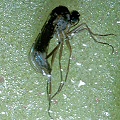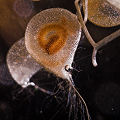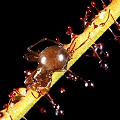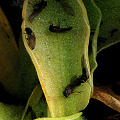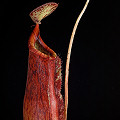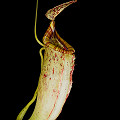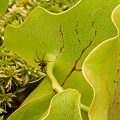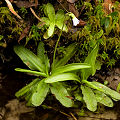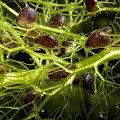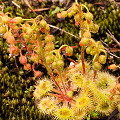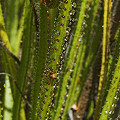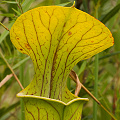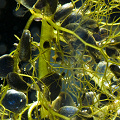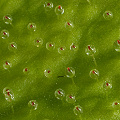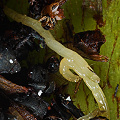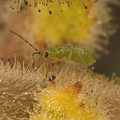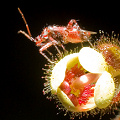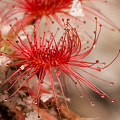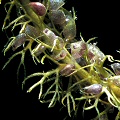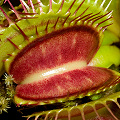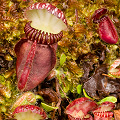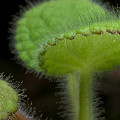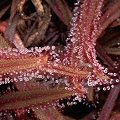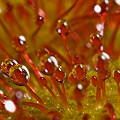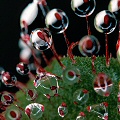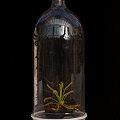Sunday, May 13, 2012
Saturday, May 12, 2012
Working on the new website
Thanks to techom.ca for the hosting! All about nepenthes over there! read our new exiting stories!
http://carnivorous.techom.ca!
Thursday, April 19, 2012
How often should I feed my plant?
The truth is, feeding your plant is the last thing you should be worrying about. Your plant only needs bugs if all its other horticultural requirements are being met. You should be worrying about the light, humidity, and water your plant is getting. Only once you have those things addressed and your plant is growing really well should you concern yourself with feeding it.
In fact, a poorly grown plant often suffers from being fed. The leaves die or get moldy. This is because the poorly grown plant can't muster the energy to properly digest the plant and so the food rots instead of being digested.
Even if healthy, your plants really do not need to be fed! They will survive perfectly well without you giving them bugs. They may grow a little slower, but they will live.
It is also likely that you don't have to feed your plants because they are getting plenty of bugs already. Unless you keep a house so clean that your coworkers like to talk about it behind your back, you actually have quite a few bugs in your house that your plant will get: gnats, roaches, flies, earwigs, and others. So relax!!
All that being said, you still probably itch to feed your plant, and I understand, so here is a simple guideline--do not feed it more than about one bug per week. If you want to feed it more often, get more plants.
P.S. Experienced carnivorous plant growers may think I'm being too hard on you, and might insist that you can feed your plants more often. The problem is that it is easy to overdo the feeding. I have conducted feeding experiments and have found that Venus flytrap deprived of food can be damaged by overfeeding. I would not be surprised if other carnivorous plants are the same way.
Thumbnail guidelines on growing a tropical pitcher plant
Let me suppose that you bought a small plant. By small, I mean a plant that occupies about as much area as your hand, with your fingers splayed. In this case, growing the plant is pretty easy. Unlike most carnivorous plants, Nepenthes do not require super bright light. So it might actually survive on a very bright windowsill. But it does like the light it would get from a bright terrarium, so don't hesitate to consider rigging up a carnivorous plant terrarium as I describe elsewhere in the FAQ. Even a bottle terrarium will be helpful if your plant is small enough.
Nepenthes plants do not like to be sitting in water, so put your little potted plant in a shallow saucer and water it every day or so---however often you find it necessary to keep the potting medium moist. If you keep it sitting in water, the root system will become dwarfed (at least for most species) and the plant will be small in general. They like conditions humid and warm. Never give them a winter dormancy, as they are tropical plants that grow year-round. If you must transplant them, put them in a mix like 50:50 Sphagnum:perlite.
Nepenthes like very high humidity, around 70-100%, so you'll need to keep it in some kind of humidity enclosure like one of the terrarium options I mentioned above.
If, for some fool reason, you have yourself a very large plant, you're going to have a devil of a time finding a place you can keep it. It will need lots of light, and plenty of humidity. Follow the same guidelines as for small plants---don't let it sit in water, but keep the soil moist. How you're going to achieve all this in a conventional house, I don't know. You really need a greenhouse.
If you try growing Nepenthes, but don't do it very well, the plant will probably survive fairly well, but might just look like a lanky vine. The pitchers the plant had when you bought it will eventually die, and the new leaves that form won't make replacement pitchers. This is very frustrating, I know. What must you do to have a plant make pitchers? Just grow the dang thing better. Pitcherless leaves, by itself, is such a general symptom that it can't be used to diagnose exactly what you're doing wrong.
If you have a Nepenthes plant and really want it to grow, I recommend you buy a book like D'Amato. That will cover all the extra stuff like fertilizing, propagation, etc.
Finally, if for some reason you have a hair up your bum to grow Nepenthes rajah as your first plant, take a pill or something. This is a very expensive plant with particular needs, and is suitable only for the expert.
What do you mean by "absorption pathways?"
A pathway is available that allows nutrients to be absorbed into the plant, thus contributing to the plant's competitive and reproductive fitness. For most carnivorous plants, nutrients are transmitted via diffusion through trap fluids. In some cases (i.e., Roridula), nutrients are first passed through the digestive tracts of mutualistic organisms and then deposited, as fecal matter, onto the leaves, whereupon they enter the plant through cuticular gaps.
The nutrients pass into plants by three mechanisms, depending upon the plant.
- Some plants have specialized cells or cellular structures to allow for the absorption of nutrients. Examples include the stalked or sessile glands of Drosera or Pinguicula, or the quadrifid glands inside the bladders of Utricularia.
- Nutrients may enter the tissues directly. The interior pitcher walls of Sarracenia lack the waxy protective layer called a cuticle. This allows the nutrients from the pitcher fluids to enter the plant.
- Nutrients may enter the tissues through specialized gaps in the cuticle. In Roridula, breaks in the cuticle allow the nutrients from hemipteran fecal matter to enter the plants. Cuticular gaps are a big liability for plants because they expose the plant to dehydration or invasion by pests and disease, so a plant will not have such gaps unless they confer a real benefit to it.
How many carnivorous plants exist?
Wednesday, April 18, 2012
What do you mean by "digestive mechanisms?"
Now we move to the second part of the three-part definition of a carnivorous plant:
A mechanism is present by which prey are degraded into a form that can be assimilated by the plant. The digestive mechanism may be enzymes produced by the plant, decomposition by bacterial activity, or other organisms in a mutualist relationship with the plant (i.e., arthropods as in the cases of Darlingtonia andRoridula).
All this means is that once the prey is captured, the prey must be digested into raw nutrients that the plant can absorb into its tissues. If you think of the trapping attribute as the plant's mouth, the digestion attribute is rather like the functions of a stomach. There are three ways that digestion can be performed:
- The plant may produce its own digestive enzymes.
- The plant may have internal parts that are populated with bacteria, mites, larval insects, etc. This is universal for all pitcher plants, even those that produce their own enzymes. Analogous to bacteria in the human gut, these organisms digest the prey for the plant.
- The plant may have external surfaces upon which live organisms such as predatory/scavenging hemipteran bugs that digest the prey, then produce excrement that can be absorbed by the plant.
You should be a little careful when looking at plants with predatory bugs crawling around on their surface. Every now and then a carnivorous plant enthusiast will report on some possible "new carnivorous plant," and will cite as evidence the fact that they saw a hemipteran crawling on it. Beware! Hemipterans crawl around on a lot of surfaces and sticky plants--that doesn't make the plant carnivorous. It is crucial that the plant has clear adaptations by which it can absorb the nutrients from the hemipteran. If the excrement from the bug just rolls off and goes into the soil to be lost, that ain't carnivory!
What do you mean by "adaptations to capture prey?"
This is the first requirement of the three-part definition of a carnivorous plant. In its full detail, the requirement is (in somewhat technical language):
The plant must have clear adaptations to capture prey. Such adaptations may include specialized structures like trapping leaves, and/or enhancements to improve the luring and capture of prey, such as extrafloral nectaries, attractive UV or pigmentation patterns, odors, hairs that guide prey, etc.
There are two parts to this. First, the plant must have a trapping mechanism. There are five different trap types that carnivorous plants have.
- Pitfall traps--such as pitcher plants like Cephalotus;
- Sticky traps--such as the sundew genus Drosera;
- Lobster pot traps--such as the marvelous Genlisea;
- Suction traps--the only genus that does this is Utricularia;
- Snap traps--for example, the famous snapping leaves of Dionaea.
The second part of this attribute is that the simple trap type mentioned above might have modifications that improve its efficiency. I'll mention some as I describe the trap types later in the FAQ, but to whet your appetite I'll mention examples:
- Plants might produce nectar as a lure;
- Plants might produce an attractive smell;
- The trap may have visual appeal--this may only be visible in UV;
- The surface of the trap might be particularly slippery or waxy;
- Hairs may be present that point prey to the point of no return;
- Special trap windows may let light in, but not allow escape--this can disorient prey;
- Trap fluids may be particularly sticky or viscous.
The importance of this attribute is that it is the basic method by which prey are captured so the plant can get on with the next stage---digestion!
Tuesday, April 17, 2012
Field trip report: Southern Portugal, late spring, 2011
The Trip:
Portugal is home to a fairly small number of carnivorous plants. However, the few carnivorous plant species it has, it has well! Of course, foremost in the minds of carnivorous plant aficionados is that this is often thought of as the home of the spectacular sticky-trap plant, Drosophyllum lusitanicum.
This plant has a unique trapping mechanism. Many people think of it as merely being another sticky-flypaper plant, such as Drosera and other genera. But Drosophyllum is different. Instead of trapping bugs by holding them tightly to the plant, Drosophyllum vomits globs of mucous onto its prey but allows the prey to move on (if it so chooses). Bugs being bugs, the prey inevitably try to clean themselves off, and in the process come into contact with more glands. In time, the bug tumbles down the nearly vertical leaves, until it becomes covered with slime and drowns.
How horrible!
This trip report includes video, in addition to the photography. This is the first time I have tried video, and I hope you enjoy the YouTube links provided throughout. My video work is, shall we kindly say, primitive. However, perhaps it adds a bit more to the trip report, in spite of its glaring weaknesses?
Start the photo-essay about Portugal!
About water
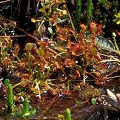 Drosera rotundifolia,
Drosera rotundifolia,
South Carolina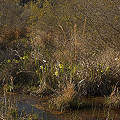 Sarracenia site,
Sarracenia site,
Texas Pinguicula site,
Pinguicula site,
Oregon Utricularia site,
Utricularia site,
Washington
Listen to me, O neophyte, and listen well. Carnivorous plants need much more water than most plants. They certainly need more water than house plants. This is because carnivorous plants are native to wetlands. They like it wet!
Carnivorous plants always need to be sitting in wet soil. How wet should the soil be? Wet wet wet. If you squeeze a handful of soil, expect water to run through your fingers and track down your arm. Wet wet wet.
Wet!
All this being said, I should mention that some carnivores like it a little drier, and some (like tuberous Drosera) even require a dry season. But compared to house plants, most carnivores want it wet. Wet wet wet. Keeping your pots sitting in a tray of water is a good idea for nearly all carnivorous plants except Nepenthes, many Pinguicula, and a few oddballs such as Drosophyllum that you probably are not growing yet.
Before you even dare to e-mail me with questions about water, make dang sure you read the next few FAQ entries about water purity!
Monday, April 16, 2012
Why doesn't my sundew have "dew" on its leaves?
So you have a sundew, and you want to see all those neato globules of goo on them, just like in my photographs, right? But your plants just are not making dew! Frustrating, isn't it?
The lack of droplets on your sundew is probably an indication that you are not growing it properly. Only a happy Drosera makes mucus. (I got that from a Chinese fortune cookie two nights ago, I swear.) The most common reason for a dewless sundew is low humidity. Other possibilities include temperatures that are too high, light that is too low, and impure water. Oh lord, you didn't fertilize your plant, did you?
These are not the only reasons your sundew may not be happy, but they are common ones.
Even if you are growing your plant properly, it might not make mucus drops. It might just be going through a dewless phase. For example, despite the best of care, the lovely African species Drosera capensis occasionally dies back to the ground. As the stem is dying back, the plant's leaves will lose their dew and look dreadful. Worry not, the plant is fine, and will resprout from the base. (I hope.)
Incidentally, spraying your sundew with water from a spray bottle is not going to help. It will hurt. The dew drops consist of a special mix of compounds, and are not just water droplets. Spray water into your own eyes if you want to see what it would feel like to the plant.
What is stranger, you---running to the internet because you have inadequate mucus drops---or me writing about them?
Moved to http://carnivorous.techom.ca/
A free domain hosting provided by a friend! Thank you for understanding
Sunday, April 15, 2012
About light / lightning
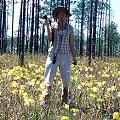
Sarracenia alata
in full sun
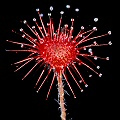
Drosera paradoxaI truly believe that the single underlying cause for most carnivorous plant deaths at the hands of beginning growers is inadequate lighting.
Indeed, I will go so far as to say that with the exceptions due to gross mistakes like fertilizings or planting in garden soils, almost all the deaths of carnivorous plants in the hands of beginning growers can be traced to inadequate lighting.
Perhaps because of the costs in specializing in carnivory, carnivorous plants require a great deal of light---most need full sun. Certainly Venus flytraps like full sun. If you do not give the plants the light that they need, you are denying them their basic energy source. And without enough energy, they cannot function. They cannot build roots or leaves, they cannot resist minor stresses such as from fungi, and they certainly cannot digest bugs.
So give them light!
Providing enough light is challenging. If you do not have a greenhouse, you will probably need to use some kind of artificial light---the windowsill will probably not be bright enough.
For illuminating terraria, you should have at least 4 fluorescent bulbs approximately 30 cm (12") from the plants. Use cool white or warm white fluorescent bulbs.
This is such an important topic that I have two more FAQ pages on light in which I discuss light intensity and light quality. You should certainly review those.
Where can I buy carnivorous plants?
Dedicated carnivorous plant nurseries are the best places to buy carnivorous plants, especially for the beginner or beginning-intermediate grower that is not too picky about looking for impossible-to-find species. Purchases can also be made via eBay, although I suggest you be cautious in such purchases.
The web sites listed below are for carnivorous plant nurseries. I am a stickler for making sure that nurseries I deal with are not involved in field collection. So in order for any online nursery to be listed on this FAQ, they must agree with the following disclaimer:
The nurseries on this page agreed with the above conservation statement. I applaud their conservation ethic and encourage you to do business with them. They are listed in alphabetical order by nursery name. When seeking plants, do not forget the benefits of joining The International Carnivorous Plant Society or the various other carnivorous plant societies. Most of these societies have seedbanks or trading parties.
For clarification, I do not patrol the web, looking for nurseries to include on this listing. If you run a nursery and agree with the conservation statement on this page, send me your data using the same format that I have below, and I will include you. It may take a few weeks for me to upload your data, so please be patient. If you have a listing, but your nursery information changes, it is your responsibility to supply updated information to me. If I encounter a nursery with a broken link I will remove it from the list. I despise dead links, and do not have time to track you down. If you notice your nursery has been removed, just contact me with the new information and I will reinstate you!
While presented in association with the International Carnivorous Plant Society, this FAQ is maintained by me (Barry Rice). As such, I do not have to be entirely impartial. Indeed, my favorite nursery listed on this page is California Carnivores, run by Peter D'Amato--master horticulturist and acclaimed author. If you are in the USA and are looking for plants, I encourage you to start there. Peter has been a longtime supporter of the ICPS. You can buy from him in safety.
Best Carnivorous Plants (Czech Republic)
E-mail: cp(at)bestcarnivorousplants.com
WWW: http://www.bestcarnivorousplants.com
Comments: An extraordinary inventory of all kinds of carnivorous plants and seeds. Will ship internationally. Plants grown from seed and tissue culture.
Borneo Exotics (Sri Lanka)
E-mail: borneo(at)lanka.net
WWW: http://www.borneoexotics.com
Comments: Nepenthes. Grown from from seed, this new firm is now exporting worldwide. At present you can look at the 300+ photographs at its web site.
Botanique (USA)
E-mail: kbailey(at)mail.rlc.net
WWW: http://www.pitcherplant.com
Comments: Sales only within the continental USA. Sarracenia, Nepenthes, Drosera, and others.
Brutala Blommor (Sweden)
E-mail: brutalablommor(at)@hotmail.com
WWW: http://brutalablommor.se
Comments: Nepenthes, Sarracenia, Cephalotus, Drosera, Pinguicula, Utricularia, Dionaea, Heliamphora. Tillandsia, and many more strange plants & equipment.
Bug Biting Plants (USA)
WWW: http://www.bugbitingplants.com
Comments: Wholesale only. Carrying Venus flytraps, sundews, cobra lilies, pitcher plants, and others.
California Carnivores (USA)
E-mail: califcarn(at)aol.com
WWW: http://www.californiacarnivores.com
Comments: Nepenthes, Sarracenia, Cephalotus, Drosera, Pinguicula, Utricularia, Dionaea, Heliamphora. Author of The Savage Garden, this source is highly recommended by the FAQ-lords.
Carnivorous Plant Nursery (USA)
E-mail: info(at)carnivorousplantnursery.com
WWW: http://www.carnivorousplantnursery.com
Comments: We provide a complete line of low-cost, high-quality carnivorous plants from around the world, as well as teaching materials for carnivorous plants. All of our plants are nursery propagated from seeds, cuttings, divisions and tissue culture.
Cascade Carnivores (USA)
E-mail: support(at)cascadecarnivores.com
WWW: http://www.cascadecarnivores.com
Comments: Online sales of dewy pines, american and tropical pitcher plants, Venus flytraps and sundews, butterworts and bladderworts. We never field collect our nursery stock. Our plants are all seed grown, propagated by division and cuttings, or grown from tissue culture. USA sales only.
Cooks Carnivorous Plants (USA)
E-mail: cooks(at)flytraps.com
WWW: http://www.flytraps.com/
Comments: Dionaea, Drosera, Sarracenia, Nepenthes, Utricularia, Pinguicula. Will ship internationally.
The CP Jungle (USA)
E-mail: cpjungle(at)aol.com
WWW: http://www.cpjungle.com
Comments: A large selection of Nepenthes, as well as many flytrap forms and Sarracenia. Has permits to ship CITES Appendix I plants, such as Sarracenia alabamensis, S. oreophila, and Sarracenia rubra subsp. jonesii.
Dangerous Plants (USA)
E-mail: thayes(at)dangerousplants.com
WWW: http://www.dangerousplants.com
Comments: A large selection of Nepenthes, Drosera & Sarracenia as well as flytrap forms, Pinguicula, Heliamphora, Cephalotus and Utricularia.
Drosera Gemmae (USA)
E-mail: droseragemmae(at)yahoo.com
WWW: http://www.droseragemmae.com
Comments: We specialize in pygmy Drosera. We have a big selection of plants and gemmae to choose from at lower prices.
Exotica Plants/Andrea and Geoff Mansell (Australia)
E-mail: exotica(at)isisol.com.au
WWW: http://www.exoticaplants.com.au
Comments: Extensive range of Nepenthes (species and hybrids) for worldwide wholesale/retail.
Flora Laboratories (Australia)
E-mail: andre(at)alphalink.com.au
WWW: http://www.alphalink.com.au/~andre
Comments: Carnivorous plant tissue culture service in Melbourne, Australia. Also supply carnivorous plants in-vitro, Keikigrow plant hormone pastes and laboratory supplies.
Hewitt-Cooper Carnivorous Plants (UK)
E-mail: nigel(at)hccarnivorousplants.co.uk
WWW: http://www.hccarnivorousplants.co.uk
Comments: Established 10 years, our range of nursery grown plants continues to increase. We supply Dionaea, Drosera, Drosophyllum seed, Pinguicula, Sarracenia, Utricularia, and sundries. Plants can be sent throughout Europe.
Houston Herpetological Supply (USA)
E-mail: info(at)houstonherp.com
WWW: http://www.houstonherp.com
Comments: Retail sales of Dionaea (Venus flytraps), Drosera (sundews), Nepenthes (tropical pitcher plants), Pinguicula (butterworts), and Sarracenia (North American pitcher plants)--all produced by tissue culture, seeds or division - via mail order/phone order. US sales only. Wholesale prices available on larger quantities.
insektenfang plants (UK)
E-mail: enquiries(at)insektenfang.com
WWW: http://www.insektenfang.com
Comments: I maintain one of the largest and most diverse Sarracenia and Dionaea collections in the country, along with substantial representation of most other carnivorous genera.
Keehns Carnivores (Canada)
E-mail: rkconcepts(at)telus.net
WWW: http://www.keehnscarnivores.ca
Comments: "in vitro"and traditional propagation of carnivorous plants. Sales to Canada. Dionaea, Drosera, Sarracenia, Nepenthes.
Malesiana Tropicals (Borneo)
E-mail: malesiana(at)tropicals.com.my
WWW: http://www.malesiana.com/html/home.htm
Comments: Retail/wholesale nursery in Borneo specializing in Nepenthes, orchids, palms, ferns, aroids, and other exotic plants.
Meadowview Biological Research Station (USA)
E-mail: meadowview(at)pitcherplant.org
WWW: http://www.pitcherplant.org
Comments: Plant sales fund restoration and research work. Dionaea, Drosera, Utricularia, Sarracenia hybrids and Sarracenia anthocyanin-free hybrids and species. Sarracenia species and regional restoration requests (e.g. Texas S. alata, S. rubra subsp. jonesiiand S. rubra alabamensis. Aldrovanda. Cephalotus. Plant sales only in USA. Specially bred Sarracenia seed.
The Nepenthes Nursery/Andreas Wistuba (Germany)
E-mail: andreas(at)wistuba.com
WWW: http://www.wistuba.com
Comments: Nepenthes, Heliamphora, Pinguicula, Cephalotus worldwide except Australia and New Zealand.
PetFlytrap (Texas, USA)
E-mail: orders(at)petflytrap.com
WWW: http://www.petflytrap.com
Comments: Primarily sells Dionaea (Venus flytraps) via mail order/phone order. Also sells other carnivorous plants, including sundews, butterworts, Sarracenia, and Nepenthes.
Predatory Plants (USA)
E-mail: info(at)predatoryplants.com
WWW: http://www.predatoryplants.com
Comments: We stock a wide selection of sundews, butterworts, Sarracenia, Nepenthes and many other plants. We ship bare-root and potted plants to anywhere in the United States.
Sarracenia Northwest Carnivorous Plants (USA)
E-mail: jeff(at)cobraplant.com
WWW: http://www.cobraplant.com
Comments: We promote the growing of Sarracenia species and Venus flytraps outdoors. We also provide a free monthly reminder on how to care for your plants all year round.
Shropshire Sarracenias (UK)
E-mail: mike(at)carnivorousplants.uk.com
WWW: http://www.carnivorousplants.uk.com
Comments: Specialising in Sarracenia species forms, named locations and hybrids (around 1,000 different clones) along with a wide range of Dionaea, I can deliver within the EU or worldwide with the appropriate CITES permits. All plants from divided stock or rhizome cuttings.
Southern Carnivores (Australia)
E-mail: phillmann(at)scarnivores.com
WWW: http://www.scarnivores.com
Comments: Nepenthes, Cephalotus, Drosera. Plants grown from seed and tissue culture. Specializing in Nepenthes and Nepenthes hybrids.
Triffid Nurseries (UK)
E-mail: andy(at)triffidnurseries.co.uk
WWW: http://www.triffidnurseries.co.uk/
Comments: Nepenthes, Sarracenia, Drosera, VFTs, Pings, Utrics, Heliamphora and Cephalotus. Plants shipped throughout Europe. Extensive CP Seed List shipped worldwide.
Triffid Park (Australia)
E-mail: triffids(at)triffidpark.com.au
WWW: http://www.triffidpark.com.au
Comments: Hundreds of species, books, etc. A very large supplier.
Tristan's Carnivorous Plants (USA)
E-mail: tristanscps(at)hotmail.com
WWW: http://www.tristanscps.com/
Comments: Specializing in Nepenthes and Sarracenia. All plants have been propagated by Tristan's Carnivorous Plants.
World of Carnivores (USA)
E-mail: sales(at)world-of-carnivores.com
WWW: http://www.world-of-carnivores.com/
Comments: Carnivorous Plant Sales & Supplies along with Care/Propagation/Tissue Culture Guides. Complete with a family oriented Forum to post questions or just chat with other CP enthusiasts.
Saturday, April 14, 2012
How do I grow carnivorous plants?
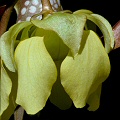
Sarracenia minor
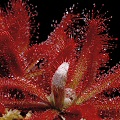
Drosera graomogolensis
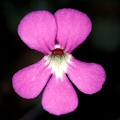
Pinguicula ehlersiae
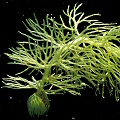
Utricularia intermediaYou must educate yourself if you want to grow carnivorous plants successfully. No amount of love or general horticultural experience will compensate for a lack of knowledge. How do you gain this precious information, normally only disclosed to the inner circle? You could read this FAQ. You could buy my book or any of the other good carnivorous plant books on the market. You could get help from another carnivorous plant grower. You could also subscribe to thecarnivorous plant mailing list or join the ICPS forum and read those for a while. If you do none of these things and simply grow your carnivorous plants like conventional, beloved house plants, your hungry botanical gems will die, I promise you.
Do not listen to the advice from people at the nursery where you bought your plant. They are usually as in the dark about these plants as you are. If you are compelled to listen to their blatherings, ask them the following key question to test their knowledge:
"Can I use coco peat in my soil mixes?"
An expert carnivorous plant grower will have an opinion either one way or the other on this question, or will tell you why it is a tricky question (having to do with sea salts). It doesn't matter which way they answer, but what does matter is that they should have a well thought out and lengthy reply for you. If your so-called expert just shrugs or gives you that deer-in-the-headlights look, smile pleasantly but don't pay attention to their other advice.
Only by using reliable sources of information will you be able to make wise cultivation decisions. Let me be firm on this---you must have good information. Otherwise, you will will select the wrong soil, water, light, humidity, temperature, and fertilizers.
Incidentally, I encourage you not to email me for help unless you have read this FAQ and can't find the answer to your question here. The FAQ has a whole lot of information in it---I'm guessing I already answered your information here somewhere. You probably don't have to wait for my sluggish and poorly worded response when this beautiful FAQ is simply awaiting your explorations.
In addition to Venus flytraps, there are hundreds of other carnivorous plant species. It should be no surprise that the different plants have different cultivation requirements (none of which are too easily satisfied). So while you will find plenty of general information about carnivorous plants throughout the FAQ, information specific to each plant genera is stored in the FAQ section that describes each genus.
But for the beginner, you should absolutely make sure you read the next several pages---everything in the beginner's section---so you have an overview of the basics.
One final comment... Consider all my cultivation information merely a set of suggestions---if the hints fail for you then try something different. Experiment!
Friday, April 13, 2012
Should I let my Venus flytrap flower?
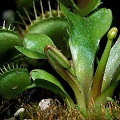
New flower stalk
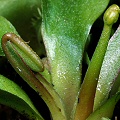
Stalk detail
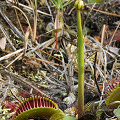
Flowering au naturalNo!
That was easy, eh? Now for the why's.
The process of making flowers takes a great deal of the plant's energy. After flowering, a Venus flytrap will be sluggish for nearly an entire year. In the wild they get over this slow period very quickly. But in cultivation, where the light, humidity, and other conditions are rarely ideal, the plants may never escape this weakened state. In fact, they may even die! This is why, unless you are a very skilled flytrap grower or have spare plants to risk, I advise you to trim those flower stalks off as soon as you can.
You can tell when your plant is going to flower because a weird cylindrical stem (unlike a leaf) will start growing out of the center of your plant. See the middle photograph to the right? The young flower stalk is on the right, while a young leaf is on the left. The flower stalk will get taller and taller, and will eventually make the rather unimpressive flowers that you see on this page. When you remove the young flower stalk, the plant may make more. Trim them off too!
Apparently, the previous paragraph is not clear enough for many of you. So let me be extra specific! See the cylindrical (rod-shaped) stalk in the bottom picture at the right? The one with the bud at the top? This is a flower stalk just emerging. Cut it off at the base.
If you wait until the flower stalks are so tall the flower buds begin to enlarge (which happens at about 10-20 cm (4-8 inches), you might as well let the plant flower--the damage is done. What the heck, pollinate the plant and maybe you'll get seed. Your flytrap is probably going to die, though, unless you are a pretty skilled grower.
You will often hear people say that the whole thing about cutting off flowers is bogus, and that their plants do just fine without the flower buds being removed. I think those people are very good growers (by luck or by skill), but have forgotten what it was like to be a beginning grower.
Thursday, April 12, 2012
Why isn't my Venus flytrap growing well?
Let me tell you one thing, though---your flytrap is not dying because you aren't feeding it enough. Flytraps can live without any bugs whatsoever!
I think that in nearly all cases, the underlying cause for Venus flytrap death by beginning horticulturists can be traced to inadequate lighting.
If you give Venus flytraps the light they need, they are really resilient little plants. If you skimp on the lighting, they are weak plants. How much lighting do they want? FULL SUN! Bright, full sun that makes you blink the sweat out of your eyes in discomfort. A gently lit windowsill is just too dim for them.
If your Venus flytrap is growing in a "bright windowsill" or terrarium with a single dinky fluorescent light over it, don't be surprised if it starts dying! I have six fluorescent bulbs over my Venus flytraps, about 30 cm (12 inches) over the plants. I've had police visit my house because I was suspected of growing marijuana. That's the kind of lighting intensity your plants need!
Wednesday, April 11, 2012
How often should I feed my Venus flytrap?
On the other hand, you do not have to feed a trap right away just because it opens. Traps can go for weeks without being fed. I have grown plants for more than a year at a time without feeding them. They grow fine, just more slowly.
I usually feed my plants about four times each year. Each plant gets about three bugs per feeding. Twelve bugs per plant doesn't seem like much, but I have about 30 plants in my terraria, so that comes to about 360 bugs. That's a lot of time spent chanting Poe in my living room, when I could be off teasing my neighbor's cat.
Tuesday, April 10, 2012
Should I transplant my Venus flytrap out of the mini-terrarium it came in?
Whatever you do, it should be to increase the likelihood that the plant is in conditions like it would expect from coastal North Carolina or South Carolina.
If you live in humid Georgia (USA) or Townsville (Australia) you do not need the mini-terrarium lid. But if you live in dry places like western Nebraska (USA) or Nagpur (India), keeping the plant in a mini-terrarium will help provide much-needed humidity.
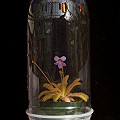
Bottle terrariumYou can make an inexpensive terrarium for your plant by modifying a 2 liter bottle of the kind that your favorite soda beverage (or drinking water) comes in. Cut the bottom off and you will have a nice little terrarium (as in the photograph to the right). If you cut off the top and the bottom to give yourself a tall transparent cylinder, and you will have a chamber that will will allow for air circulation, which might be good, but the humidity will tend to be lower.
One thing you can do to help a Venus flytrap in a tiny pot stay healthy is to not overwater it. Keep the plant wet, but do not keep the pot sitting in more than a few centimeters of water. A deeply submerged pot cannot get enough oxygen. Water your plant frequently, but do not make it sit in too much water.
If you want to upgrade the size of your plant's growing area even more, you should look at the FAQ entries that talk about terrarium construction.
If you have questions on how to transplant your Venus flytrap, look at my transplant instructions.
